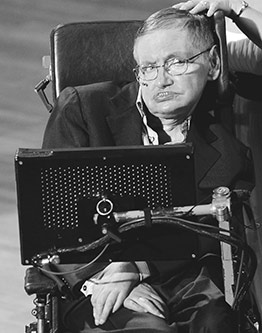Last year was all about rockets, rockets, rockets
 CREDIT: JEMAL COUNTESS/GETTY IMAGES ENTERTAINMENT/THINKSTOCK
CREDIT: JEMAL COUNTESS/GETTY IMAGES ENTERTAINMENT/THINKSTOCKThe year 2014 was a big one for space news. Stephen Hawking opposed his black hole theory.
The year 2014 was a good year for space enthusiasts. Between Stephen Hawking negating his black hole theory with new grey holes, and the flurry of rocket travel in the latter part of the year, the previous year gave thousands of hours of research for the world to pore over.
In the first six months, we saw a number of asteroid encounters, some closer than others. In early March, three separate incidents within two days came between the Earth and the moon, the smallest measuring 25 ft. across while the largest came in at 100 ft. – the length of a Boeing 737.
On January 31, the National Aeronautics and Space Administration’s (NASA) Curiosity rover photographed Earth and the moon from Mars for the first time. It’s a small solar system.
NASA’s Lunar Atmosphere and Dust Environment Explorer probe orbited the moon a final 100 times just one kilometre from the surface, then it was intentionally crashed on April 18.
In May, a completely new meteor shower was born – The Camelopardalids, originating from the recently-discovered Comet 209P/ LINEAR.
In July, Russia launched an experiment containing five geckos, testing how vertebrates developed in microgravity. The geckos gained viral status when the experiment lost radio contact. Contact was re-established, but it was determined that the geckos froze when the heater failed.
India’s first probe to Mars, the Mangalyaan, successfully reached its target on September 24 – costing less than Hollywood blockbuster Gravity – becoming only the third nation to succeed in reaching Mars. NASA’s MAVEN probe also arrived at the red planet three days before Mangalyaan, studying the Martian atmosphere.
The U.S. Air Force X-37B unmanned spacecraft returned after 675 days in orbit. Not much else is known about this mysterious craft, cue conspiracy theories.
A once-in-a-million-year event, the Comet Siding Spring sailed past Mars on October 19, giving new information about the solar systems composition roughly 4.6 billion years ago.
The largest sunspot recorded in 24 years was observed on October 22, with a diameter larger than Jupiter. It’s been a quite active year for the sun, including several X Class solar flares right after this event.
The Antares rocket exploded over its launch pad, destroying 5,000 lbs. of International Space Station-bound supplies on October 28. Three days later, the Virgin Galactic SpaceShipTwo ripped itself apart over the Mojave Desert, killing one test pilot.
The ESA successfully became the first to land a probe on a comet. The Rosetta orbiter carried its Philae lander to Comet 67P/Churyumov- Gerasimenko, touching down on November 12.
NASA launched its first Orion capsule atop the United Launch Alliance Delta 4 Heavy rocket, the vehicle sending humans to Mars in 2030. Delayed a day after faulty valves remained closed, Orion had a successful launch on December 5, successfully travelling through the Van Allen belt – a high radiation field surrounding the Earth – then splashing down in the Pacific Ocean.
BONUS
Everything Elon Musk has done with SpaceX. This man deserves an article alone, but between the first private company hired to send humans into space for NASA to his bold plans for Mars colonization, this has been a good year for SpaceX, even with a failed test in July.
In addition to these discoveries, a vast amount of data from 2013 was analyzed from dozens of experiments, giving even more new information. But that’s just the beginning – between massive solar flares hitting Earth in September and super moons all summer, there was so much to talk about during the last year.
Food, cosmetics, racecar technology – it can all be linked to research and discoveries in space. So go out and discover something you love.













